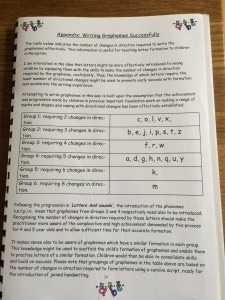Whole School Literacy
Megan Dixon and I are attempting to create a Literacy Leader group. Here is the list of interested people so far…
mainstreamsen.wordpress.com/20…
And this is the first blog by Megan.
Books – A Journey
by Megan Dixon (@DamsonEd) Director of Literacy for The Aspire Educational Trust
I like reading. I like books that make me think. I like books that challenge me to think in different ways. I don’t always agree with them, or like what they say. I don’t always enjoy the process of reading them. But I like the way they help me to understand from a different viewpoint. Below are some books that I return to again and again.
I would be very grateful for any other suggestions!
Oakhill, Cain and Elbro (2015) Understanding and Teaching Reading Comprehension. Routledge
This is great! Clarke et al (2012) Developing Reading Comprehension, Wiley, is good too.
Goswami (2014) Child Psychology; A very short Introduction. Oxford. Small enough to slip into a pocket. Fascinating
Blakemore and Frith (2005) The Learning Brain, Lessons for Education. Blackwell. I found this to be very clearly explained and often use extracts for it for training.
Paley (1991) The Boy who would be a helicopter. Uses of Story Telling in the Classroom. This is a really thought-provoking read, especially if you work with younger children. A technique for developing story telling/drama called Helicopter Stories was developed by MakeBelieveArts from the writings of Paley. It has been very successful at our school, providing a forum for oral story-telling and developing communication skills.
Haven (2000) Story Proof – The science behind startling power of story. Why we all need stories in our lives.
Gross (2013) Time to Talk, Routledge. Essential reading (in my opinion). Especially if you are interested in teaching literacy/reading/writing . “Written by the government’s former Communication Champion for children, it showcases and celebrates effective approaches in schools and settings across the country. Jean Gross helpfully summarises research on what helps children and young people develop good language and communication skills, and highlights the importance of key factors: a place to talk, a reason to talk and support for talk.”
Thank you Megan for these recommendations – what a great list.
I might add Wolf, (2008) Proust and the Squid, Icon Books. An interesting read on “The Story and Science of the Reading Brain’.
Add to Showcase
Share on Twitter Share on Facebook
AUTHOR PROFILE
Me
ME
Literacy and Language Co-ordinator. Formerly an English and Drama teacher. Own views.
english
94 stories
COMMENTS
Stephen Lockyer
Stephen Lockyer
@mrlockyer
2 years ago
Both Story Proof and the helicopter story book look really interesting! Great to see such a different range of interesting books for Education – thank you!
Recommend
Stephanie Keenan
Stephanie Keenan
@mskeenan
2 years ago
Thanks for sharing! Keen on work of Gross. Will check out those I haven’t read 🙂
Recommend
Me
Jules Daulby
@jules
2 years ago
Yes a great list from Megan isn’t it? I agree too about the different range – the little Goswami book was my half term reading and was interesting.
Recommend
Me
Jules Daulby
@jules
2 years ago
Some new ones for me too Stephanie
Recommend
Deborah Banks
Deborah Banks
@dba
2 years ago
Good titles …some to get! I really like Geoff Barton’s Don’t Call It Literacy…last year we had it as a whole school ‘class reader’ for staff and structured T&L meetings around it. Also love Daniel Willingham’s Why Students Don’t Like School which looks at how the brain works and how curricula often are structured counter productively. Finally, my fav read is Isabel L Beck’s Bringing Words to Life about how to teach vocabulary beyond just subject specifics.
Recommend
Stephen Lockyer
Stephen Lockyer
@mrlockyer
2 years ago
So I found a link to the first 20 pages of Story Proof (legally!) here: https://books.google.co.uk/books?id=uspfMRlGXVoC&pg=PR5&source=gbs_selected_pages&cad=3#v=onepage&q&f=false
Recommend
Me
Jules Daulby
@jules
2 years ago
@dba great – I will add onto blog this eve – thanks and to you @mrlockyer for link #hooter
Recommend
Abigail Mann
Abigail Mann
@abster
2 years ago
Ooh these are great! Thank you to Megan for sharing. I have a few books to buy now. I also have Why Students Don’t Like School and am working my way through it slowly.
Recommend
Sinead Gaffney
Sinead Gaffney
@shinpad1
2 years ago
I read ‘Literacy and popular culture’ by Jackie Marsh in 2002, the first academic book I read as a practising teacher. It started me off on a whole new way of thinking about literacy and seeing the school experience from the chd’s perspective. (She’s my supervisor now!). My Y1/2 classroom had been quite formal until then. I tried a Spider-Man theme for a half-term and boom! children wanted to write. My tough-guy boys were climbing over each other to get into the reading corner/writing table. I’d recommend it. Her more recent work on including digital literacy experiences in the classroom is also well worth a look. I really like this list and will return to it!
Recommend
Me
Jules Daulby
@jules
2 years ago
#hooter @abigailmann
Recommend
Me
Jules Daulby
@jules
2 years ago
@sineadgaffney firstly realised you’re not ony list – will rectify. And I will add that to blog – wonderful story and love that she’s your supervisor now- thanks
Recommend
Sinead Gaffney
Sinead Gaffney
@shinpad1
2 years ago
Also this recent padlet by @marygtroche is worth its weight in gold. Such a wealth of reading experience and thinking in it. http://padlet.com/marygtroche/usefulresources
Recommend
Me
Jules Daulby
@jules
2 years ago
Great – I think we may need a 2nd blog – might be over 500 word limit – will do tonight – great response – thanks to everyone especially to Megan for getting us started
Recommend
Megan Dixon
Megan Dixon
@damsoned
2 years ago
Thanks Jules! I’m off to buy a book or two!
Recommend
Me
Jules Daulby
@jules
2 years ago
Me too @damsoned – think will do a second blog with others Part 2 🙂
Recommend
Jenna Lucas
Jenna Lucas
@jenna
2 years ago
Thanks for the recommendations! I have an ever growing ‘book’ wish list! I’ve just started @learningspy’s The Secret of Literacy.
Recommend
Me
Jules Daulby
@jules
2 years ago
Ah yes – we should add to list – another one I need to read …
2 years ago
Inspiring reading list – they’re going on my summer reading list! Thanks
2 years ago
Fantatsic list here and have added a few to my school’s CPD library.
















